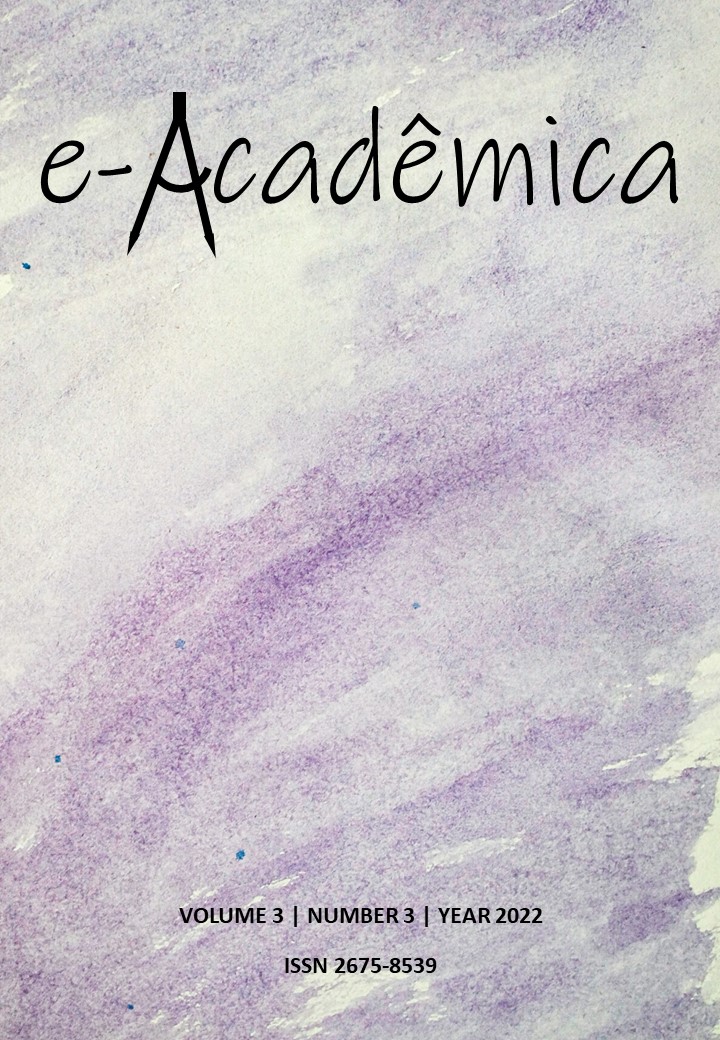Comparative study of two auxiliary chemical substances protocols used two dental school (USP and UNICAMP)
DOI:
https://doi.org/10.52076/eacad-v3i3.242Keywords:
Instrumentation; Chemical substance; Protocols; Chemical-surgical preparation.Abstract
All technological advances, with the central point of improving chemical-surgical preparations and increasingly efficient mechanical instrumentation, an effective endodontic failure rate has decreased due to advances in the introduction of new auxiliary active substances for instrumentation such as hypochlorite solution of sodium and chlorhexidine that offer the possibility of disinfection of the root canal system and the need for new protocols that can be performed in a single session. Therefore, the objective of this investigation, based on the pertinent literature of 30 scientific articles researched in the Google and Academic PubMed databases identified until May 2021, was to compare the action of two irrigating substances, sodium hypochlorite and chlorhexidine, both used in protocols from different faculties, one from the Faculty of Dentistry of the University of São Paulo that uses sodium hypochlorite solution for its ability to dissolve tissues in addition to having antibacterial action, and another from the Faculty of Dentistry of the University of Campinas that uses chlorhexidine, in the form of gel or liquid, as an irrigant, whose differential is that it has the property of agglutinating the entire dental substrate, not being toxic to periodontal tissues and having a long-lasting antimicrobial action.
References
Antonelli A, Giovannini L, Baccani I, Giuliani V, Pace R, & Rossolini G. M. (2019) In Vitro Antimicrobial Activity of the Decontaminant HybenX® Compared to Chlorhexidine and Sodium Hypochlorite against Common Bacterial and Yeast
MT, Ordinola-Zapata R, Baca P, Ruiz-Linares M, García García E, Hungaro Pathogens. Antibiotics (Basel). 17;8(4):188.
Arias-Moliz Duarte M. A, Monteiro Bramante C, & Ferrer-Luque C M. (2015) Antimicrobial activity of Chlorhexidine, Peracetic acid and Sodium hypochlorite/etidronate irrigant solutions against Enterococcus faecalis biofilms. Int Endod J. 48(12):1188-93.
Ávila L. M, Santos M, Siqueira E. L, Nicoletti M. A, & Bombana A. C. (2010) Análise das soluções de hipoclorito de sódio utilizadas por endodontistas. RSBO Rev Sul-Brasileira Odontol 7(4):396-400.
Bevilacqua I. M, Habitante S. M, & Cruz C. W. (2004) A clorexidina como alternativa no tratamento de infecções endodônticas: revisão da literatura. Rev. Biociên Taubaté. jul./set; 10(3): 139-145.
Bonan R. F, Batista A. U. D., & Hussne R. P. (2011) Comparação do Uso do Hipoclorito de Sódio e da Clorexidina como Solução Irrigadora no Tratamento Endodôntico: Revisão de Literatura, Rev Bras Ci Saúde. 15(2):237-244.
Caetano N. C, Monteiro S. C, Abreu A. C. T., Souza A. C. N., & Chianca G. C. (2019) Avaliação microbiológica da clorexidina e do hipoclorito de sódio na terapia endodôntica: revisão literária de estudos clínicos. Rev Bras Odontol, 76:(Supl.2):99.
Freitas S. V, Tomazinho L. F, Batista M. I. H. M., Carvalho A. A. T., & Paulino M. R. (2020) Consequências e condutas clínicas frente a acidentes por extravasamento de NaOCl em endodontias. Rev. CES Odont; Enero – Junio; 2020 33(1): 44-52.
Gavini G. Manual de fundamentos teóricos e práticos em endodontia. (2018) FOUSP, p..28, 45 http://repositorio.fo.usp.br:8013/jspui/bitstream/fousp/40/2/Manual%20Endo%20Completo%202019.pdf
Gatelli G, & Bortolini, M. C. T. (2014) O uso da clorexidina como solução irrigadora em endodontia. Rev Uningá Review, 20(1):119-122.
Jain K, Agarwal P, Jain S, Seal M, & Adlakha T. (2018) Alexidine versus chlorhexidine for endodontic irrigation with sodium hypochlorite. Eur J Dent. Jul-Sep;12(3):398-402.
Keles A, Ors S. A, & Yilmaz Z. (2020) Effect of various solutions on the removal of orange-brown precipitate formed by interaction of sodium hypochlorite and chlorhexidine with or without ultrasonic activation. Niger J Clin Pract. Mar;23(3):381-385.
Khademi A. A, Mohammadi Z, & Havaee A. (2006) Evaluation of the antibacterial substantivity of the several intracal agents. Aust Endod J; Dec; 32(3):112-115.
Kist S, Kollmuss M, Jung J, Schubert S, Hickel R, & Huth K. C. (2017) Comparison of ozone gas and sodium hypochlorite/chlorhexidine two-visit disinfection protocols in treating apical periodontitis: a randomized controlled clinical trial. Clin Oral Investig. May; 21(4):995-1005.
Kulkarni S, Mustafa M, Ghatole K, AlQahtani A. R, I Asiri F. Y, Alghomlas Z. I, Alothman T. A, & Alhajri F. F. (2021) Evaluation of 2% Chlorhexidine and 2% Sodium Fluoride as Endodontic Irrigating Solutions on Root Dentine Microhardness: An In Vitro Study. Eur J Dent. May;15(2):253-258.
Macias J. H, Arreguin V, Munoz J. M, Alvarez J. A, Mosqueda J. L, & Macias A. E. (2013) Chlorhexidine is a better antiseptic than povidone iodine and sodium hypochlorite because of its substantive effect. Am J Infect Control. Jul; 41(7):634-7.
Martins C. M, Machado N. E. S., Giopatto B. V., Batista V. E. S., Marsicano J. A., & Mori G. G. (2020) Post-operative pain after using sodium hypochlorite and chlorhexidine as irrigation solutions in endodontics: Systematic review and meta-analysis of randomised clinical trials. Indian J Dent Res. Sep-Oct; 31(5):774-781.
Mohammadi Z, & Abbott P. V. (2009) The properties and applications of chlorhexidine in endodontics. Int Endod J. Apr; 42(4):288-302.
Noites R, Carvalho M. F, & Vaz I. P. (2009). Complicações que podem surgir durante o Uso do Hipoclorito de Sódio no Tratamento Endodôntico, Rev Portuguesa Estomatol, Med Dent Cir Maxilofacial; Jan-Feb; 50(1):53-56.
Pretel H., Bezzon F, Faleiros F. B. C., Dametto F. R, & Vaz L. G. (2011) Comparação entre soluções irrigadoras na endodontia: clorexidina x hipoclorito de sódio. RGO (Online) Jan/Jun; 59(1):127-132.
Pinheiro S. L, Silva C. C. D., Silva L. A. D., Cicotti M. P., Bueno C. E. D. S., Fontana C. E., Pagrion L. R., Dalmora N. P., Daque T. T., & Campos F. U. (2018) Antimicrobial efficacy of 2.5% sodium hypochlorite, 2% chlorhexidine, and ozonated water as irrigants in mesiobuccal root canals with severe curvature of mandibular molars. Eur J Dent. 12(1):94-99.
Ribeiro, A. L. M., & Camargo J. C. S. (2019) Comparação da eficácia antimicrobiana de solucões irrigadoras: Hipoclorito de Sódio 2,5% e Clorexidina 2%. Uberaba-MG, 22 f. Trabalho de Conclusão de Curso (Bacharelado em Odontologia) – Universidade de Uberaba.
Rôças I. N, & Siqueira J. F Jr. (2011) Comparison of the in vivo antimicrobial effectiveness of sodium hypochlorite and chlorhexidine used as root canal irrigants: a molecular microbiology study. J Endod Feb;37(2):143-50.
Rossi- Fedele, G, & Rödig, T. (2022) Effectiveness of root canal irrigation and dressing for the treatment of apical periodontitis: A systematic review and meta- analysis of clinical trials. Int Endod J, 00, May; 1–14. Available from: https://doi.org/10.1111/iej.13777.
Saba K, Maxood A, Abdullah S, Riaz A, & Uddin S. (2018) Comparison of frequency of pain in root canal treatment using sodium hypochlorite and chlorhexidine as root canal irrigants. J Pak Med Assoc. Sep; 68(9):1334-1338.
Santos T. L, Dall’Magro E, Kuhn-Dall’Magro A, Corrêa B, Fronza B. M, & Colla F. (2012) Ação antimicrobiana do hipoclorito de sódio a 2,5% e clorexidina gel 2% em raízes contaminadas com Enterococcus faecalis. Rev Fac Odontol Passo Fundo maio/ago; 17(2):150-155.
Sariyilmaz E, Sivas Yilmaz Ö, Keskin C, & Keleş A. (2019) Effect of sodium hypochlorite and chlorhexidine irrigating solutions and their inactivating agents on the push-out bond strength of mineral trioxide aggregate. Biomed Mater Eng; Jan; 30(3):279-285.
Sarmento E. B, Guimarães L, Tavares S, Azevedo Batistela Rodrigues Thuller K, Antunes L, Antunes L, & Gomes C. (2020) The Influence of Sodium Hypochlorite and Chlorhexidine on Postoperative Pain in Necrotic Teeth: A Systematic Review. Eur Endod J. Dec;5(3):177-185.
Silva T. M, Alves F. R, Lutterbach M. T, Paiva M. M, Ferreira D. C. (2018) Comparison of antibacterial activity of alexidine alone or as a final irrigant with sodium hypochlorite and chlorhexidine. Braz Dent J Open. Jun; 1;4:18003.
Silva J. P. M., & Boijink D. (2019) Acidente com hipoclorito de sódio durante tratamento endodôntico: análise de prontuário Rev Odontol Araçatuba Jan/Abr; 40(1):25-28.
Simionato MR. Anti-sépticos em odontologia. (2018). https://edisciplinas.usp.br/pluginfile.php/4466087/mod_resource/content/1/Aula%20te%C3%B3rica%20Anti-s%C3%A9pticos%20de%20uso%20em %20Odontologia.pdf.
Smenoff, T. A. D. V., Semenoff-Segundo A., Borges A. H., Pedro F. M. L. P., Caprossi L. S., & Rosa-Junior A. (2010) Atividade antimicrobiana da clorexidina a 2%, hipoclorito de sódio a 1% e paramonoclorofenol com furacin sobre S. aureus, C. albicans, E. faecalise e P. aureginosa. Rev. Odontol Ciênc. (Online); 25(2):174-177.
Solda G. S. M. L. Comparação da eficácia do hipoclorito de sódio e da clorexidina como soluções irrigadoras nos tratamentos endodônticos. (2021). 46 p. Trabalho de Conclusão de Curso (graduação) - Universidade Federal de Santa Catarina, Centro de Ciências da Saúde, Graduação em Odontologia, Florianópolis.
Walia V, Goswami M, Mishra S, Walia N, & Sahay D. (2019) Comparative Evaluation of the Efficacy of Chlorhexidine, Sodium Hypochlorite, the Diode Laser and Saline in Reducing the Microbial Count in Primary Teeth Root Canals - An In Vivo Study. J Lasers Med Sci. Oct Fall;10(4):268-274.
Downloads
Published
How to Cite
Issue
Section
License
Copyright (c) 2022 João Marcelo Ferreira de Medeiros; Gabriel de Souza Ferreira ; Kariny do Carmo Lima; Irineu Gregnanin Pedron; Caleb Shitsuka

This work is licensed under a Creative Commons Attribution 4.0 International License.
Autores que publicam nesta revista concordam com os seguintes termos:
1) Autores mantém os direitos autorais e concedem à revista o direito de primeira publicação, com o trabalho simultaneamente licenciado sob a Licença Creative Commons Attribution que permite o compartilhamento do trabalho com reconhecimento da autoria e publicação inicial nesta revista.
2) Autores têm autorização para assumir contratos adicionais separadamente, para distribuição não-exclusiva da versão do trabalho publicada nesta revista (ex.: publicar em repositório institucional ou como capítulo de livro), com reconhecimento de autoria e publicação inicial nesta revista.
3) Autores têm permissão e são estimulados a publicar e distribuir seu trabalho online (ex.: em repositórios institucionais ou na sua página pessoal) a qualquer ponto antes ou durante o processo editorial, já que isso pode gerar alterações produtivas, bem como aumentar o impacto e a citação do trabalho publicado.










